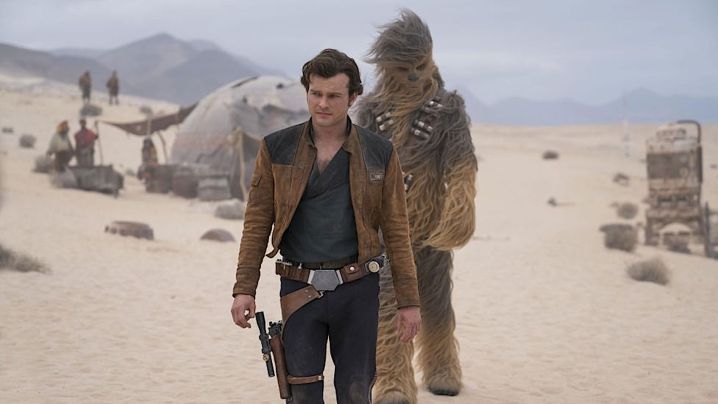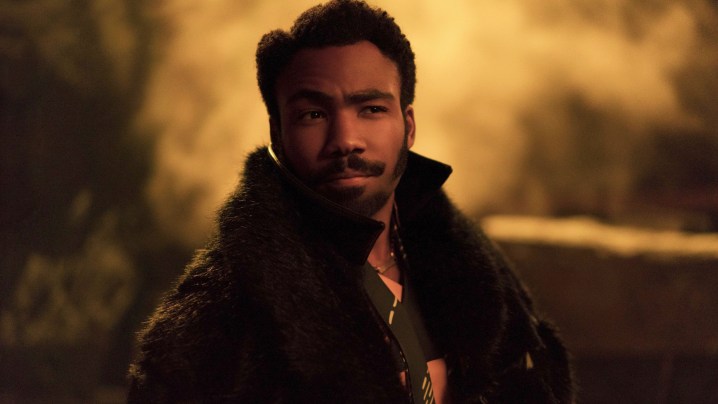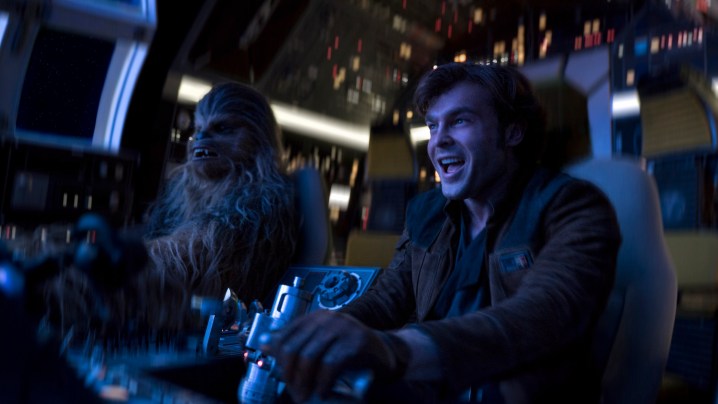For no good reason at all — and certainly not one related to its content — Solo: A Star Wars Story has become the bastard child of Disney’s Star Wars family, a scapegoat for all the rushed and bad choices made by Disney and Lucasfilm honcho Kathleen Kennedy during the first phase of the Disney Star Wars era (the era that included the sequel trilogy, Rogue One, and Solo).
Other than the distant possibility of a Lando Calrissian spin-off series starring Donald Glover, Solo has become film non grata in the Star Wars universe, despite Disney’s seeming willingness to make TV shows out of every square inch of it. Remember that scene in The Empire Strikes Back when ice falls onto R2-D2’s head in the Hoth Echo Base corridor? Disney recently announced a 16-episode series about what happened in that corridor. OK, not really, but I’m guessing it also wouldn’t surprise anyone if it turned out to be true.
Solo, on the other hand, opens up acres of great story possibilities that will likely go unexplored. Given that Star Wars has boxed itself in at the story level, Disney should reconsider the story possibilities inherent in Solo, a movie that is not only much better than its reputation but is one of the better Star Wars movies in general.

Problems with Disney Star Wars productions
When Disney execs gained control of Star Wars from George Lucas, they were like a kid whose grandpa gave them 10 dollars and told them not to spend it all in one place — at which point they immediately spent it all in one place. Between 1977 and 2015, six Star Wars feature films existed. Between 2015 and 2019, Disney made five. Given the enormous world-building required and the expense and scale of these productions, that in itself seemed folly unless great stories existed on the page, ready to film.
They didn’t. The studio more or less made them up as they went, resulting in the reengineering of Rogue One in post-production, and the schizophrenic sequel trilogy, which is several disparate story ideas glued together (with really weak glue).
The most ominous sign that a film is in trouble is when the director is replaced during production. This is a rare occurrence, but with Disney’s Star Wars features, it happened an absurd three times in five films. While Gareth Edwards wasn’t technically replaced on Rogue One — he is still credited as the film’s director — Disney did bring in another writer/director, Tony Gilroy (who wrote the Bourne movies) to do extensive reshoots. J.J. Abrams stepped in to replace Colin Trevorrow on The Rise of Skywalker. And veteran Ron Howard took over from the hot directing duo, Phil Lord and Christopher Miller (The Lego Movie, 21 Jump Street), on Solo.

All of this suggests that not only was there no guiding or coherent vision to begin with, but that the producers had little idea who they were hiring, what their capabilities were, or even what it takes to make a Star Wars film in the first place. J.J. Abrams, admittedly, was the right choice to kick everything off with The Force Awakens, given the excellent work he did rebooting Star Trek in terms of both story/character and VFX. After that, it seems as though Disney was trawling for hot young names. After all, why not just go with a reliable helmsman like Ron Howard in the first place?
Kennedy recently admitted that Solo was a misconception from the onset, particularly casting another actor as Han Solo. “There should be moments along the way when you learn things. Now it does seem so abundantly clear that we can’t do that,” she said, which is easy to say when the film wasn’t as critically or commercially successful as you expected (Solo remains the lowest grossing of the Star Wars feature films). But wouldn’t she say something similar about Rogue One if it hadn’t been a global success — that they departed too far from the Star Wars formula by not focusing on the relationships enough? Or by giving the film such a dark ending?

I suspect that the success of Rogue One was as least partially due to the fact that it came out just a year after the massive global domination of The Force Awakens, a movie that people were initially pretty excited about (though over the years, esteem for it has declined). Audiences wanted more of that feel-good Star Wars stuff and those appealing new characters like Rey, Finn, and Kylo Ren, and I’m guessing that some of the viewers who went to Rogue One didn’t even realize that those characters wouldn’t be in it.
Solo, on the other hand, suffered from audience fatigue (it was the fourth Star Wars film in three and a half years), as well as the growing divide among fans about the direction Star Wars was taking, especially The Last Jedi, which some people vocally disliked, and which had been released just six months earlier. Then, of course, there was the negative press about Solo‘s production problems, as well as replacing Harrison Ford with Alden Ehrenreich just a few years after bringing Ford himself back as the iconic character. In all, Solo ran into some bad luck (it is, after all, a movie about gamblers). Still, none of this means it’s not a strong film, something fans, casual viewers, and Disney execs alike may want to rediscover.
Solo’s cast and characters are welcome SW additions

The obvious starting point for assessing any movie chronicling the adventures of a young Han Solo is the actor playing the man. Stepping into the shoes of a legend like Harrison Ford is all but impossible, especially when you consider how responsible both the actor and the character are for humanizing the original trilogy and helping it not lean too far into the saga of humorless space wizards as, well, the prequels did. But if we accept there’s no replacing Ford, then we can relax into this alternate version of the character played by Alden Ehrenreich.
This is made easier by the fact that Ford himself never seemed young on-screen even in a movie like Lucas’ American Graffiti when he was 31. Ehrenreich seems not only young, but guileless, even gullible, and the key to his effectiveness on screen — in fact, the main reason the movie works — is because this is Han Solo with an open heart. He’s not yet ruined by cynicism and betrayal in the classical style of the heartbroken Rick Blaine in Casablanca, immortally played by Humphrey Bogart. Ford in the original films does evoke Bogart, but Ehrenreich resolutely does not and that’s a good thing because Bogart never seemed young either.

Young Solo’s openness, enthusiasm, and optimism play well against the more seasoned rogues he hooks up with including Lando, Beckett (Woody Harrelson), and Qi’ra (Emilia Clarke) his erstwhile girlfriend, who has learned a lot more about surviving in the galactic underworld than Solo has during their three years apart.
In general, the movie is well populated with compelling characters that are well played by these actors and others, including the crime boss, Dryden Voss (Paul Bettany), Beckett’s lover and partner in crime (Thandiwe Newton, who rightfully complained about her lack of screen time), the incomparable Phoebe Waller-Bridge as the voice of the droid L3-37, and Erin Kellyman as a freedom fighter with a secret.
The filmmaking is top-notch

Once you can move past the Han Solo origin moments and Easter eggs (how he got his name, how he and Chewbacca (Joonas Suotamo) met, how he came into possession of the Millennium Falcon) that dominated much of the movie’s initial reception, you can relax into a well-made and absorbing story. Ron Howard may never be considered an auteur by the highfalutin standards of cineastes, but he is a total professional, an Oscar winner (for directing A Beautiful Mind), and a proficient craftsman with special effects in movies like Backdraft and Apollo 13.
It’s not entirely clear where Howard’s contributions begin after taking over from Lord and Miller (he shot about 70% of the movie), but one thing is clear: at the basic level of staging, shooting, cutting, sound, and VFX, Solo is a polished directorial achievement, and one that moves, which all good Star Wars movies should, but especially one that’s leaning into the heist genre for its story beats.
Much of the credit for this goes to Pietro Scalia for the editing. Again, it’s not always clear who does what behind the scenes, especially in movies that pass through this many hands, but Scalia is an accomplished editor, a two-time Oscar winner for his famously brilliant work on Oliver Stone’s JFK and Ridley Scott’s Black Hawk Down. And this movie is fleet, hurtling from sequence to sequence with just the right number of slower beats to let viewers catch their breath.
But great editing wouldn’t work without excellent shots to begin with, and Solo is a visual achievement, even in an era in which such things feel ho-hum. There’s a clarity and spatial elegance to the action scenes, which is highlighted during a train heist set on a mountainside. Why anyone in this universe would use a train for transport when they have spaceships goes unanswered, but never mind, it’s a thrilling sequence that is always coherent despite the myriad moving parts — multiple parties trying to get their hands on this shipment while multiple other parties try to protect it.
Solo expertly expands the Star Wars world

Solo also unfurls from a deceptively sophisticated script by Jonathan and Lawrence Kasdan (the elder Kasdan worked on scripts for The Empire Strikes Back, Return of the Jedi, and The Force Awakens, so he clearly understands Star Wars). The first two-thirds of the picture is breathless chases and heists and escapes, but in the last third, the Kasdans connect the story to the larger Star Wars universe to show how and why the older Solo eventually committed to the Rebel Alliance. When Han is not sure of his identity and Qi’ra tells him, “You’re one of the good guys,” it’s poignant and moving because viewers can see know how badly the depth of his feelings will wound him, and how lonely he will feel until he hooks up with the Skywalkers years later.
The script also masterfully opens up sequel possibilities. Unlike other Star Wars content, such as Obi-Wan Kenobi, which becomes proscribed and constricted because we know the outcome, Solo spins wide-open story trajectories in multiple directions: the further adventures of Han and Chewie, Lando’s escapades, the galactic underworld of the Hutts and other gangsters, the marauding Imperialism of the Empire, the development of the nascent Rebel Alliance, and (spoiler) the nefarious exploits of the movie’s hidden villain, Darth Maul (Ray Park) and the nature of his bond with Qi’ra.
Disney and Kathleen Kennedy seem embarrassed by Solo, but that’s because they don’t realize what they have in this movie, not at all surprising given all the problems with this franchise under Disney’s colonial flag. Instead, they double down on dreck like The Book of Boba Fett, the fatuous offspring of the tedious The Mandalorian (or as I like to call it, The Manda-snorian or, wait…Manda-borian?), because Fett is a “fan favorite.”
But unlike those shows, Solo possesses the heart, the romance, and the adventure that made the original Star Wars films so beloved. Perhaps Kennedy and her cohort should hold a screening of Solo, one in which they forget the bellowing trolls and the soulless logic of focus groups, and just try to remember what it feels like to have fun at the movies.
Editors' Recommendations
- 5 things we need to see in The Mandalorian & Grogu Star Wars movie
- Han Solo vs. Indiana Jones: Which one is Harrison Ford’s greatest role?
- Disney shifts release dates for Marvel movies, Star Wars films, and Avatar sequels
- Han Solo is the best sci-fi character ever. Here’s why
- Want to enjoy the Star Wars TV shows more? Watch the cartoons, already!



